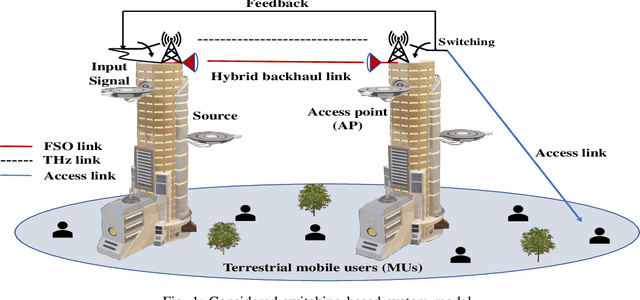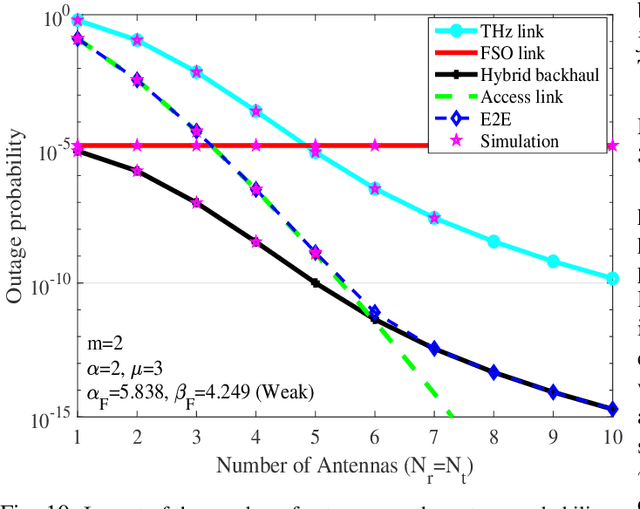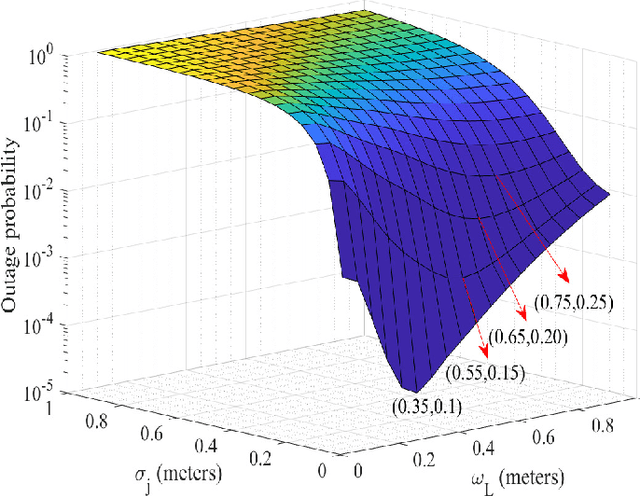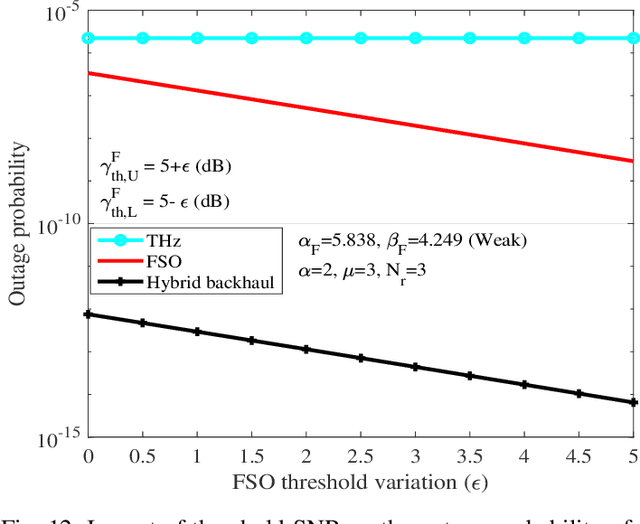Praveen Kumar Singya
On Performance of Integrated Satellite HAPS Ground Communication: Aerial IRS Node vs Terrestrial IRS Node
Dec 30, 2023Abstract:With a motive of ubiquitous connectivity over the globe with enhanced spectral efficiency, intelligent reflecting surfaces (IRS) integrated satellite-terrestrial communications is a topic of research interest in an infrastructure-deficient remote terrains. In line with this vision, this paper entails the performance analysis of satellite-terrestrial networks leveraging both aerial and terrestrial IRS nodes, with the support of high altitude platforms over diverse fading channels including shadowed Rician, Rician, and Nakagami-$m$ fading channels. The merits of IRS in enhancing spectral efficiency is analyzed through closed-form expressions of outage probability and ergodic rate. Further, the average symbol error rate analysis for the higher-order quadrature amplitude modulation (QAM) schemes such as hexagonal QAM, rectangular QAM, cross QAM, and square QAM is performed. Practical constraints like antenna gains, path loss, and link fading are considered to characterize the satellite terrestrial links. Finally, a comparison between the high-altitude platforms based IRS node and terrestrial IRS nodes is performed and various insights are drawn under various fading scenarios and path loss conditions. This paper contribute towards understanding and potential implementation of IRS-integrated satellite-terrestrial networks for efficient and reliable communication.
Multi-hop Sub-THz-FSO: A Technique for High-rate Uninterrupted Backhauling in 6G
Dec 10, 2023Abstract:Moving towards $6^{\text{th}}$ generation (6G), backhaul networks require significant improvements to support new use-cases with restricted joint capacity and availability requirements. In this paper, we investigate the potentials and challenges of joint sub-teraHertz (sub-THz) and free space optical (FSO), in short sub-THz-FSO, multi-hop networks as a candidate technology for future backhaul communications. As we show, with a proper deployment, sub-THz-FSO networks have the potential to provide high-rate reliable backhauling, while there are multiple practical challenges to be address before they can be used in large-scale.
High-rate Reliable Communication using Multi-hop and Mesh THz/FSO Networks
Apr 04, 2023Abstract:In this work, we consider multi-hop and mesh hybrid teraHertz/free-space optics (THz/FSO)-based backhaul networks for high data-rate communications. The results are presented for the cases with both out-band integrated access and backhaul (IAB) and non-IAB based communication setups. We consider different deployments of the THz and FSO networks and consider both switching and combining methods between the hybrid FSO/THz links. We study the impact of atmospheric turbulence, atmospheric attenuation, and the pointing error on the FSO communication. The THz communication suffers from small scale fading, path-loss, and the misalignment error. Finally, we evaluate the effects of atmospheric attenuation/path-loss, pointing/misalignment error, small-scale fading, atmospheric turbulence, number of antennas, number of user equipments, number of hops, and the threshold data-rates on the performance of considered systems. As we show, with different network deployments and switching/combining methods, the hybrid implementation of the THz/FSO links improves the network reliability significantly.
Hybrid FSO/THz-based Backhaul Network for mmWave Terrestrial Communication
Apr 18, 2022



Abstract:In this work, a hybrid free-space optics (FSO)/ teraHertz (THz) based backhaul network is considered to provide high-data rate reliable communication to the terrestrial mobile users (MUs) operating at millimeter wave (mmWave) bands. The FSO link is affected by the atmospheric turbulence and pointing error impairments which are characterized with Gamma-Gamma and Rayleigh fading, respectively. At the FSO receiver, both the intensity modulated direct detection and heterodyne detection techniques are considered. The multi-antenna THz link suffers from both high path-loss and misalignment error. The THz channel is characterized with $\alpha-\mu$ distribution and misalignment error is characterized with Rayleigh fading. To minimize the effect of back-and-forth switching, soft switching method is introduced at the access point (AP) to select the signal coming through the hybrid FSO/THz link, and a comparison with hard switching method is presented. Selective decode-and-forward relaying is considered at the AP which is forwarding the successfully decoded backhaul signals to the terrestrial MUs. In this context, we derive closed-form expressions of the individual link's outage probability, end-to-end (E2E) outage probability, asymptotic outage probability, ergodic capacity, and average bit-error-rate of various modulation schemes. Finally, we study the effect of different parameters such as atmospheric turbulence, pointing/misalignment errors, link distance, path-loss, fading parameters of the THz and access links, and number of antennas on the network performance. Our results indicate that, with a proper switching method, the joint implementation of FSO/THz links, improves the rate/reliability of the backhaul links with limited switching overhead.
Performance of UAV assisted Multiuser Terrestrial-Satellite Communication System over Mixed FSO/RF Channels
Sep 13, 2021



Abstract:In this work, performance of a multi-antenna multiuser unmanned aerial vehicle (UAV) assisted terrestrial-satellite communication system over mixed free space optics (FSO)/ radio frequency (RF) channels is analyzed. Downlink transmission from the satellite to the UAV is completed through FSO link which follows Gamma-Gamma distribution with pointing error impairments. Both the heterodyne detection and intensity modulation direct detection techniques are considered at the FSO receiver. To avail the antenna diversity, multiple transmit antennas are considered at the UAV. Selective decode-and-forward scheme is assumed at the UAV and opportunistic user scheduling is performed while considering the practical constraints of outdated channel state information (CSI) during the user selection and transmission phase. The RF links are assumed to follow Nakagami-m distribution due to its versatile nature. In this context, for the performance analysis, analytical expressions of outage probability, asymptotic outage probability, ergodic capacity, effective capacity, and generalized average symbol-error-rate expressions of various quadrature amplitude modulation (QAM) schemes such as hexagonal-QAM, cross-QAM, and rectangular QAM are derived. A comparison of various modulation schemes is presented. Further, the impact of pointing error, number of antennas, delay constraint, fading severity, and imperfect CSI are highlighted on the system performance. Finally, all the analytical results are verified through the Monte-Carlo simulations.
 Add to Chrome
Add to Chrome Add to Firefox
Add to Firefox Add to Edge
Add to Edge